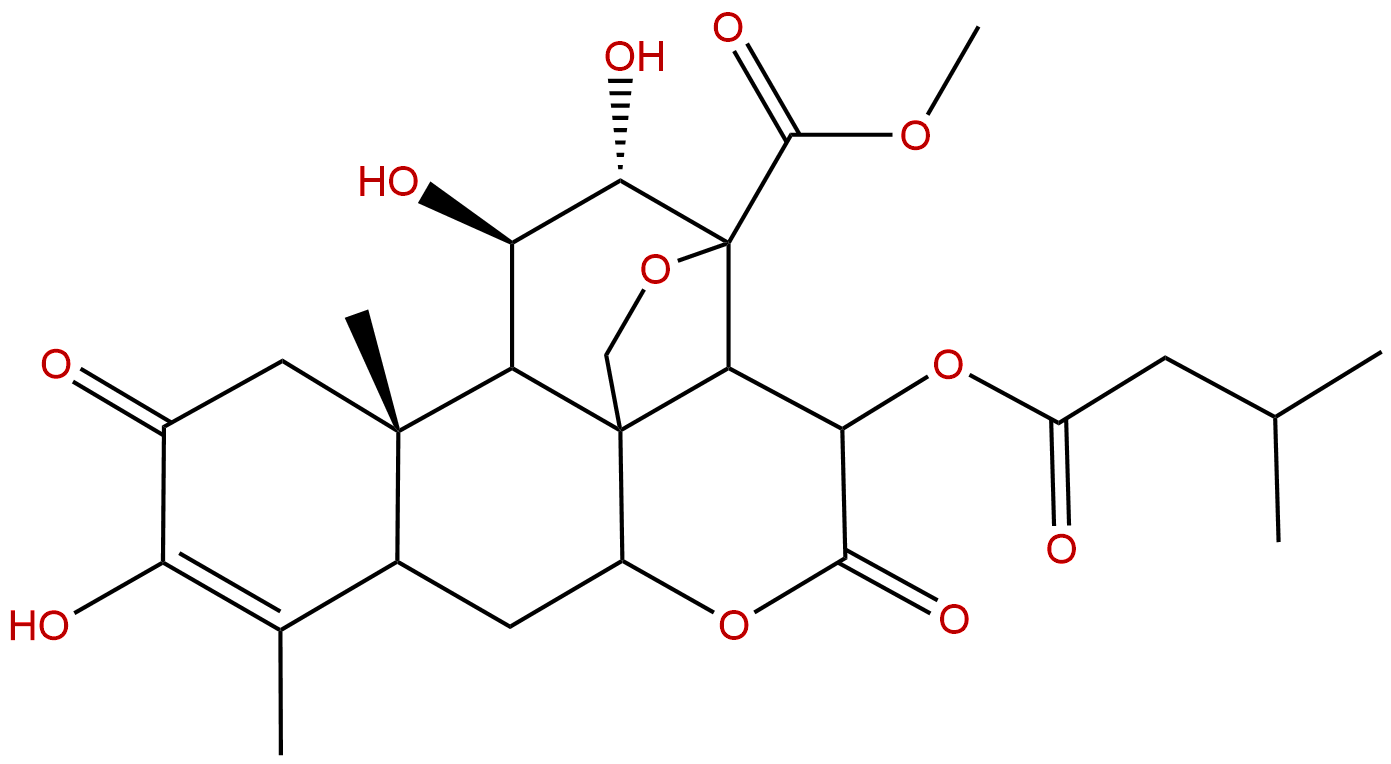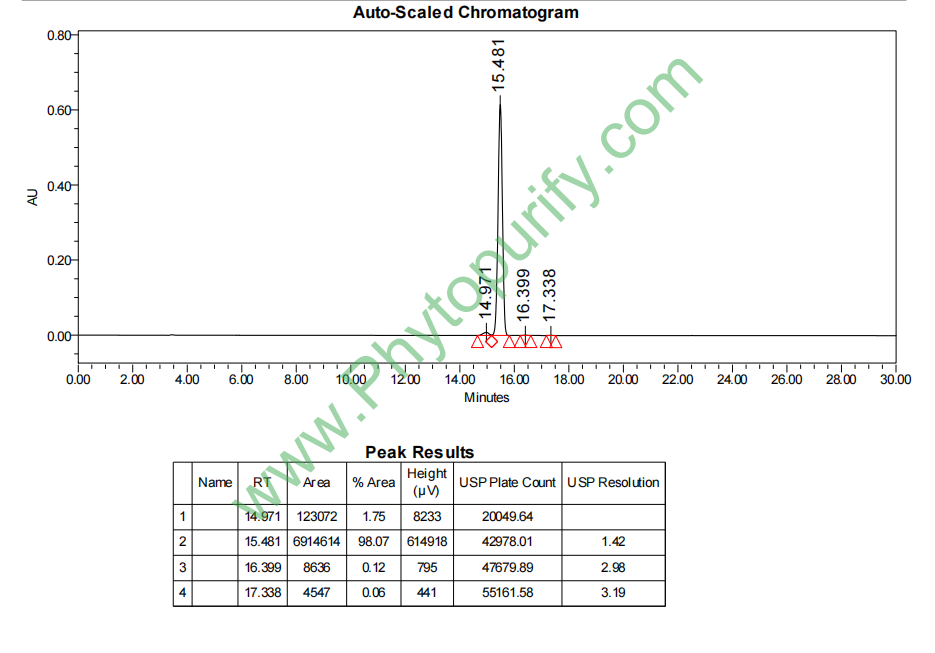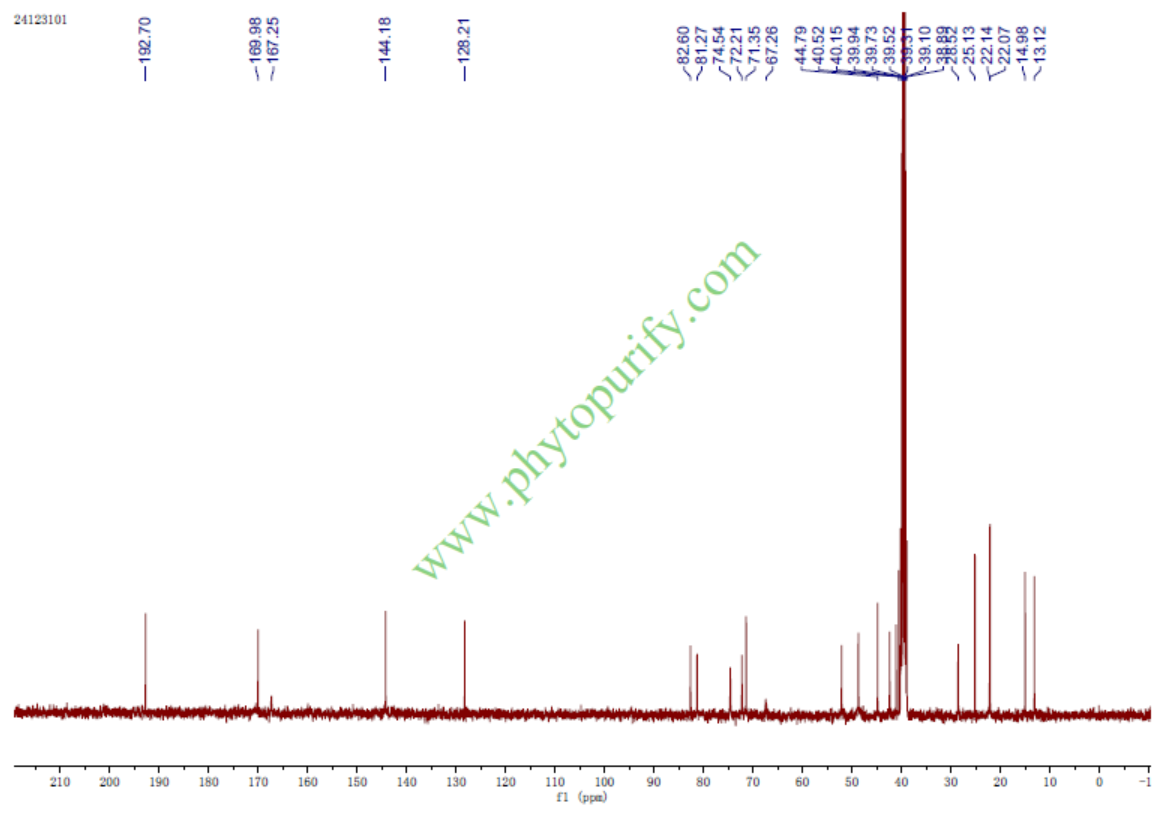
Bruceine ACAS No.:25514-31-2
|
||||||||||
 |
|
|
||||||||

| Catalogue No.: | BP3089 |
| Formula: | C26H34O11 |
| Mol Weight: | 522.547 |
Product name: Bruceine A
Synonym name:
Catalogue No.: BP3089
Cas No.: 25514-31-2
Formula: C26H34O11
Mol Weight: 522.547
Botanical Source:
Physical Description:
Type of Compound: Diterpenoids
Purity: 95%~99%
Analysis Method: HPLC-DAD or/and HPLC-ELSD
Identification Method: Mass, NMR
Packing: Brown vial or HDPE plastic bottle
The product could be supplied from milligrams to grams. Inquire for bulk scale.
We provide solution to improve the water-solubility of compounds, thereby facilitating the variety of activity tests and clinic uses.
For Reference Standard and R&D, Not for Human Use Directly.
Description:
Bruceine A has antibabesial activity, it can inhibit the in vitro growth of Babesia gibsoni in canine erythrocytes at lower concentration and kill the parasites within 24 hr at a concentration of 25 nM; it show strong antitrypanosomal activities with IC(50) values in the range of 2.9-17.8nM. Bruceine A has anthelmintic activity, it exhibits significant activity against Dactylogyrus intermedius with EC(50) values of 0.49 mg/L. Bruceine A exhibits NF-κB p65 inhibition, and cytotoxic potential against HT-29, HeLa, and HL-60 cells .
References:
Vet Parasitol. 2008 Dec 20;158(4):288-94.
In vitro antitrypanosomal activities of quassinoid compounds from the fruits of a medicinal plant, Brucea javanica.
The medicinal plant Brucea javanica (L.) Merr. (Simaroubaceae) is widely distributed throughout Asia where its bitter fruits have been used in traditional medicine for various ailments.
METHODS AND RESULTS:
Fifteen C-20 quassinoids were isolated from the fruits of B. javanica and examined for their in vitro antitrypanosomal activities against trypomastigotes of Trypanosoma evansi. Bruceine A, bruceantinol, bruceine C, brusatol, and bruceine B showed strong antitrypanosomal activities with IC(50) values in the range of 2.9-17.8nM, which compared well with the standard trypanocidal drugs diminazene aceturate (IC(50)=8.8nM) and suramin (IC(50)=43.2nM). However, dehydroBruceine A, dehydrobruceine B, and dehydrobrusatol were about 2100, 900, and 1200 times less active, respectively, than Bruceine A, bruceine B, and brusatol.
CONCLUSIONS:
The relationship of the structure and antitrypanosomal activity of these quassinoid compounds suggested that the presence of a diosphenol moiety in ring A and the nature of the C-15 side chain are important for their activities against T. evansi. This is the first report on the antitrypanosomal activity of isolated quassinoids.of the C-15 side chain are important for their activities against T. evansi. This is the first report on the antitrypanosomal activity of isolated quassinoids.
Vet Parasitol. 2011 Apr 19;177(1-2):127-33.
In vivo anthelmintic activity of bruceine A and bruceine D from Brucea javanica against Dactylogyrus intermedius (Monogenea) in goldfish (Carassius auratus).
The present study was designated to ascertain the anthelmintic activity of the dried fruits of Brucea javanica and to isolate and characterise the active constituents.
METHODS AND RESULTS:
The methanol extract from the fruits of B. javanica showed significant anthelmintic activity against Dactylogyrus intermedius (EC(50) (median effective concentration) value=49.96 mg l(-1)). Based on this finding, the methanol extract was fractionated on silica gel column chromatography in a bioassay-guided fractionation affording two known quassinoids showing potent activity, Bruceine Aand bruceine D. Both Bruceine A and D exhibited significant activity against D. intermedius with EC(50) values of 0.49 mg l(-1) and 0.57 mg l(-1), respectively, which were more effective than the positive control, mebendazole (EC(50) value=1.25 mg l(-1)). In addition, the 48-h median lethal concentration (LC(50)) for Bruceine A and D against the host (Carassius auratus) was 10.6-fold and 9.7-fold higher than the EC(50) for D. intermedius.
CONCLUSIONS:
These results provide evidence that the isolated compounds might be potential sources of new anti-parasitic drugs for the control of Dactylogyrus. This is the first report on an in vivo anthelmintic investigation for B. javanica against D. intermedius.
J Vet Med Sci. 2009 Jan;71(1):33-41.
Evaluation of efficacy of bruceine A, a natural quassinoid compound extracted from a medicinal plant, Brucea javanica, for canine babesiosis.
Bruceine A, a natural quassinoid compound extracted from the dried fruits of Brucea javanica (L.) Merr., was evaluated for its antibabesial activity in vitro and in vivo.
METHODS AND RESULTS:
Bruceine A inhibited the in vitro growth of Babesia gibsoni in canine erythrocytes at lower concentration compared with the standard antibabesial drug diminazene aceturate and killed the parasites within 24 hr at a concentration of 25 nM. Oral administration of Bruceine A at a dosage of 6.4 mg/kg/day for 5 days resulted in no clinical findings in a dog with normal ranges of hematological and biochemical values in the blood. Three dogs were infected with B. gibsoni and two of them were treated with Bruceine A at a dosage of 6.4 mg/kg/day for 6 days from day 5 post-infection. An untreated dog developed typical acute babesiosis symptoms including severe anemia, high fever, and complete loss of appetite and movement. However, the two Bruceine A-treated dogs maintained their healthy conditions throughout the experimental period of 4 weeks although complete elimination of parasites from the peripheral blood was not achieved and decreases in the packed cell volume and the erythrocyte and platelet counts were observed.
CONCLUSIONS:
Since natural quassinoid compounds have been used as traditional medicines for the treatment of various ailments including cancer and malaria, the present results suggest that Bruceine A or other related compounds are potential candidates for the treatment of canine babesiosis.
Bioorg Med Chem. 2009 Mar 15;17(6):2219-24.
Bioactivity-guided isolation of cytotoxic constituents of Brucea javanica collected in Vietnam.
METHODS AND RESULTS:
Five new triterpenoids (1-5), together with two known quassinoids, bruceantin (6) and Bruceine A (7), and a known flavonolignan, (-)-hydnocarpin (8), were isolated from the chloroform-soluble subfraction of a methanol extract of the combined twigs, leaves, and inflorescence of Brucea javanica collected in Vietnam. The structures of the new compounds 1-5 were established on the basis of spectroscopic methods. All isolates were evaluated for cytotoxicity against a small panel of human cancer cell lines.
CONCLUSIONS:
Quassinoids 6 and 7 were found to be highly active against these cell lines. (-)-Hydnocarpin (8) showed a potentiating effect when combined with both 6 and 7, during cytotoxicity testing using the MCF-7 human breast cancer cell line.
HPLC of Bruceine A

NMR of Bruceine A
